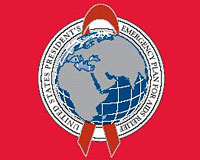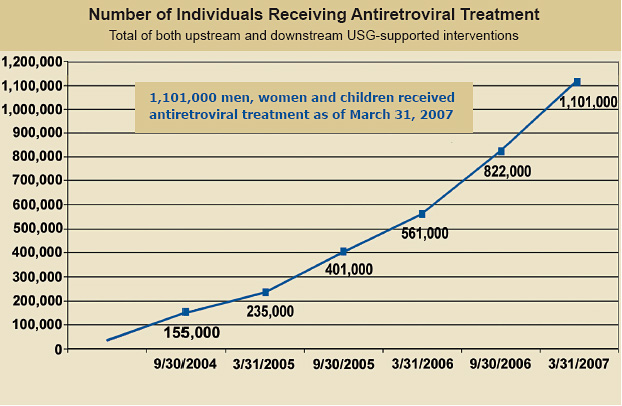| Latest 2007 PEPFAR Treatment Results PDF version PDF version
 |
President George W. Bush's
Emergency Plan for AIDS
Relief is the largest commitment
ever by any nation for an
international health
initiative dedicated to
a single disease-- a
five-year, $15 billion,
comprehensive approach to
combating the disease
around the world.
U.S. Department of
State
U.S. Agency for
International
Development
U.S. Department of
Defense
U.S. Department of
Commerce
U.S. Department of
Labor
U.S. Department of
Health and Human
Services
Peace Corps
Mailing address:
SA-29, 2nd Floor
2201 C Street, NW
Washington, DC 20522-2920
www.PEPFAR.gov
| |
|
“The Emergency Plan has supported treatment for 1.1 million people infected with HIV. … Today I ask Congress to demonstrate America’s continuing commitment to fighting the scourge of HIV/AIDS by reauthorizing this legislation now. I ask Congress to double our initial commitment and approve an additional $30 billion for HIV/AIDS prevention, for care, and for treatment over the next five years.”
- President George W. Bush, May 30, 2007 Latest 2007 PEPFAR Treatment Results
The President’s Emergency Plan for AIDS Relief (Emergency Plan/PEPFAR) has supported life-saving antiretroviral treatment for approximately 1,101,000 men, women and children through bilateral programs in the Emergency Plan’s 15 focus countries in sub-Saharan Africa, Asia and the Caribbean.
- PEPFAR is on track to meet its five-year goal of support for treatment for 2 million HIV infected people.
- Before President Bush announced PEPFAR in 2003, it is estimated that only 50,000 people in sub-Saharan Africa were receiving antiretroviral treatment.
These latest results underscore America’s commitment to work in partnership with host nations to turn the tide against HIV/AIDS.
- These results are not fundamentally the work of the American people, but represent the dedication and commitment of individuals, communities and nations to take control of the HIV/AIDS epidemics in their countries.
- The Emergency Plan was the first quantum leap in America’s leadership on global HIV/AIDS. America has kept its promise, and continues to lead the world in its level of support for effective partnerships against HIV/AIDS.
- PEPFAR works with host nations to build capacity in-country: more than 80 percent of partners are indigenous organizations.

The U.S. President’s Emergency Plan for AIDS Relief (Emergency Plan/PEPFAR) is the largest commitment ever by a single nation toward an international health initiative — a five-year, $15-billion, multifaceted approach to combating HIV/AIDS around the world. PEPFAR employs the most diverse prevention, treatment and care strategy in the world, with an emphasis on transparency and accountability for results. The goals of the Emergency Plan include support for treatment for 2 million HIV infected people, support for prevention of 7 million new infections, and support for care for 10 million people infected or affected by HIV/AIDS. |
|

Through the power of partnerships with our host nations, the Emergency Plan also supports prevention and care programs, which had provided the following as of September 30, 2006:
- Prevention of mother-to-child HIV transmission services for women during more than 6 million pregnancies;
- Antiretroviral prophylaxis for women during 533,700 pregnancies;
- Prevention of an estimated 101,500 infant infections;
- Care for nearly 4.5 million people, including more than 2 million orphans and vulnerable children; and
- 18.7 million counseling and testing sessions for men, women and children.
|
|
While the focus of PEPFAR is on prevention, treatment and care of people living with HIV/AIDS, the impact of PEPFAR need not be limited to HIV/AIDS.
- PEPFAR is part of a broad and bold development agenda and is central to U.S. efforts to “connect the dots” of international development. Emergency Plan programs are increasingly linked to important U.S. initiatives in other areas of health and development, such as the Millennium Challenge Corporation, the President’s Malaria Initiative, the African Education Initiative, the Women’s Justice and Empowerment initiative and others.
- President Bush, with the strong bipartisan support of Congress and the American people, has doubled resources for development overall, and with his 2008 budget request will have quadrupled them for Africa.
|
Number of Individuals Receiving Antiretroviral Treatment as of March 31, 2007 |
| |
Downstream1 |
Upstream2 |
Total |
| Botswana |
0 |
84,900 |
84,900 |
| Cote d'Ivoire |
25,800 |
8,600 |
34,400 |
| Ethiopia |
61,300 |
0 |
61,300 |
| Guyana |
1,900 |
0 |
1,900 |
| Haiti |
10,100 |
0 |
10,100 |
| Kenya |
116,900 |
9,400 |
126,300 |
| Mozambique |
28,200 |
25,200 |
53,400 |
| Namibia |
32,900 |
0 |
32,900 |
| Nigeria |
73,900 |
18,800 |
92,700 |
| Rwanda |
20,200 |
17,000 |
37,200 |
| South Africa |
146,300 |
150,400 |
296,700 |
| Tanzania |
56,700 |
2,600 |
59,300 |
| Uganda |
66,600 |
34,600 |
101,200 |
| Vietnam |
6,300 |
3,900 |
10,200 |
| Zambia |
98,500 |
0 |
98,500 |
| Total |
745,600 |
355,400 |
1,101,000 |
NOTE: Numbers may be adjusted as attribution criteria and reporting systems are refined. Numbers above 100 are rounded to the nearest 100.
1 Included in downstream results are individuals reached through service delivery sites that are directly supported by USG interventions/activities (e.g. commodities, drugs, supplies, supervision, training or quality assurance) at the point of service delivery. Results are considered “downstream” if they can be associated with counts of uniquely identified individuals receiving services at unique program or service delivery points.
2 Included in upstream results are estimates of individuals served as a result of the USG’s contribution to systems strengthening beyond those counted as receiving direct USG support. Systems strengthening includes support to national, regional, or local activities such as policy development; institutional capacity building; logistics; protocol or guideline development; advocacy; laboratory support; national, regional training; and national management information systems. Upstream support is vital to creating sustainable national systems.
Botswana results are attributed to the National HIV/AIDS Program. Beginning in FY2005, following a consensus reached between the USG and the Government of Botswana, USG reports its contributions in the form of a single national figure for each relevant indicator. | |
| |  |  |




 PDF version
PDF version